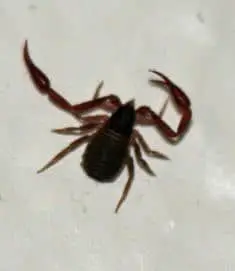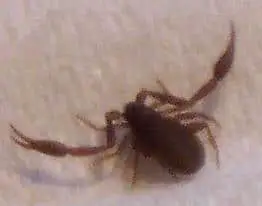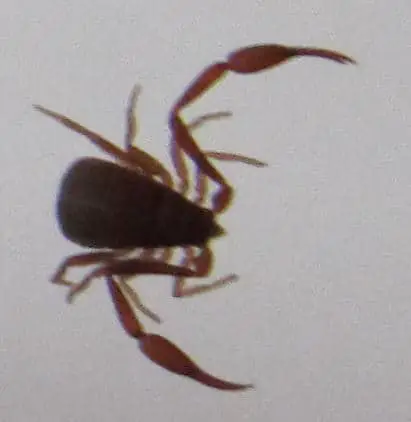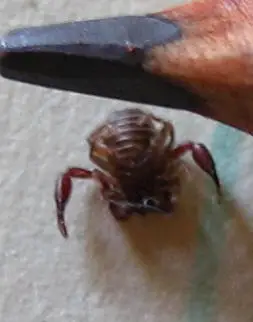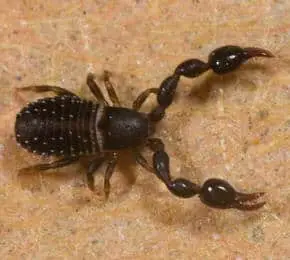Pseudoscorpions are small arachnids with a flat, pear-shaped body and pincers that resemble those of scorpions. They usually range from 2 to 8 millimetres (0.079 to 0.31 in) in length. The largest known species is Garypus titanius of Ascension Island at up to 12 mm. The abdomen, known as the opisthosoma, is made up of twelve segments, each protected by plates (called tergites above and sternites below) made of chitin. The abdomen is short and rounded at the rear, rather than extending into a segmented tail and stinger like true scorpions (the fact that they look exactly like scorpions, aside from not having a stinger tail, is the source of the name “Pseudoscorpion”). The color of the body can be yellowish-tan to dark-brown, with the paired claws often a contrasting color. A pseudoscorpion has eight legs with five to seven segments; the number of fused segments is used to distinguish families and genera. They have two very long ng color. They may have two, four or no eyes. A pseudoscorpion has eight legs with five to seven segments; the number of fused segments is used to distinguish families and genera. They have two very long palpal chelae (pedipalps or pincers) which strongly resemble the pincers found on a scorpion.
The pedipalps generally consist of an immobile “hand” and “finger”, with a separate movable finger controlled by an adductor muscle. A venom gland and duct are usually located in the mobile finger; the poison is used to capture and immobilize the pseudoscorpion’s prey. During digestion, pseudoscorpions pour a mildly corrosive fluid over the prey, then ingest the liquefied remains. Pseudoscorpions spin silk from a gland in their jaws to make disk-shaped cocoons for mating, molting, or waiting out cold weather. Another trait they share with their closest relatives, the spiders, is breathing through spiracles. However, they do not have book lungs as most spiders do.
Information Wikipedia
All photos are copyright to their owners and may not be reproduced without permission.
Here’s some photos and information from viewers:
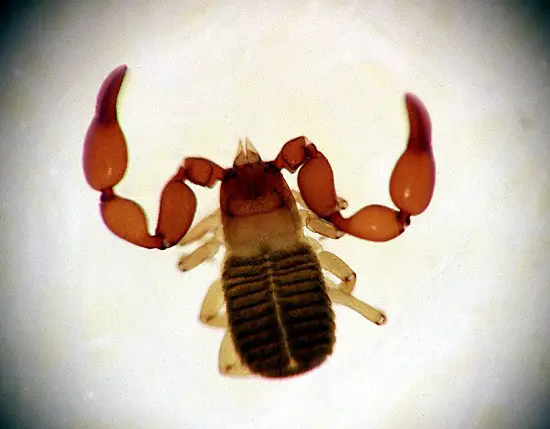
This photo was sent in by Jon Triffo, from Saskatchewan in Canada. Here’s Jon’s information and his photo. Thanks for the great photo, Jon!!
Here’s Jon’s information:
“They are surprisingly toxic, but only to tiny creatures as they are unable to pinch through human flesh or deliver any significant dose of venom. As it is their pincers that are armed with venom, they tend to react like mini, wee boxers when approached. I’ve found some to be even pugnacious and always ready for a fight, irregardless of any mismatch in weight classification. I have yet to find any way of keeping pseudoscorpions alive for more than several days, so I no longer try to keep them in captivity. It’s just not fair to the wonderful little creatures.
Domestically, I’ve observed that they usually erupt from household hiding places whenever ant bait is set out to kill ants throughout a home.Perhaps there are ecological links between ants and pseudoscorpions.
I placed a small green fly, similar to a lacewing, in a jar with a pseudoscorpion once. When I saw that the fly was more than twice the size of the pseudoscorpion, I thought that maybe I should continue looking for more suitable prey. The pseudoscorpion approached the fly, however, and repeatedly jabbed at it it with its pincers. Within several minutes the fly was either paralysed or deceased and the pseudoscorpion was feasting upon it! Much to my dismay, however, the pseudoscorpion died two days later.
In a school in Toronto, Ontario, I set up a macro photography display and I used a mounted pseudoscorpion on a pin as my subject of focus. Each class in the school, with all the teachers and many parents, toured the exhibit after I presented a brief introduction and workshop on wildlife photography. 98% of all the participants in the tour lined up to view and practice focusing on the amazing little pseudoscorpion. Some of them, especially the kids of course, began looking for pseudoscorpions in their own homes. The venomous little wonder became a bit of a sensation in an inner city school that was very “challenging” to teach in.
I don’t know if Australia has pseudoscorpions or not . . . if they exist there, I hope your school finds them plentiful and fascinating.”
Jon
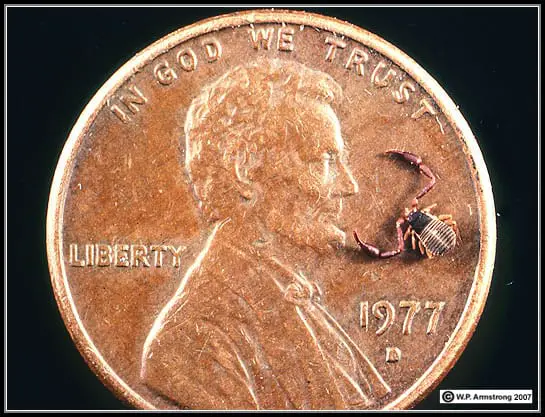
A modern-day pseudoscorpion sitting on the head of a U.S. penny. This is actually an arachnid that mimics scorpions as a defense mechanism. They are only present when micro-organisms like lice and other bugs are present, or in very humid conditions.


